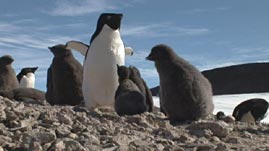Teachers' Domain - Digital Media for the Classroom and Professional Development
User: Preview

Source: "Penguin Science"



This video segment adapted from Lloyd Fales and Sweetspot Pictures, Inc. examines how the changing Antarctic climate affects the Adélie penguins that live there. Learn about the penguin colonies on Ross Island and see how changes due to global warming affect the success of these colonies. For example, ecologist Grant Ballard points out a snowfield where thousands of penguins were buried alive during a single powerful storm. While storms can also help break up the ice to increase access to open waters, other rapid climate change events, such as the massive iceberg that broke off the Ross Ice Shelf in 2000, block access between penguin feeding and breeding grounds and cause populations to decline.
While a number of penguin species inhabit the Antarctic region, only two types of penguins—Emperor and Adélie—thrive in the true, environmentally harsh Antarctic. These two species are the most southerly of all penguins and breed exclusively on the Antarctic continent. Adélie penguins, in particular, offer one of the best views into how living things adapt to rapid climate change.
Adélie penguins breed on rocky Antarctic beaches in colonies of up to hundreds of thousands. Their breeding grounds must meet certain conditions: they must have gentle, ice-free slopes where the penguins can build nests out of small stones, and they must be close to open water so that the penguins can reach their food (krill and fish). As a result, the colonies are generally located on rocky coasts where strong winds and currents break up the sea ice and push it away from the continent, giving the penguins easy access to their food.
Ross Island currently hosts several Adélie colonies; however, the colonies have not always been located there. Researchers have found that the current favorable conditions are relatively new and that the Ross Island colonies were likely established only within the past 1,000 years. Prior to that, it appears that the Adélies had abandoned the colonies during a cold period when the Ross Ice Shelf extended farther north than it does now. The expanded ice would have blocked access to open water and increased the distance that the penguins had to travel for food; as a result, the penguins abandoned these colonies in favor of better habitats elsewhere.
In this sense, some warming actually benefits the Adélie penguins. Increased temperatures and stronger winds result in less sea ice and provide easier access to their food. Since the 1970s, breeding success has increased in some Adélie colonies and populations have grown. Retreating glaciers may also help increase breeding success by creating more rocky, ice-free breeding grounds. However, climate change also has negative effects. Changes in their food supply may cause colonies to fail and penguin numbers to decline. As seen in the video, massive icebergs can dramatically affect penguin populations by blocking access between their breeding and feeding areas. In addition, Adélies do not compete well with other penguins that succeed in warmer environments; as the warmer temperatures reach farther south, the Adélies will likely abandon the warmer colonies in favor of establishing new colonies where there are colder conditions. Global warming also brings less predictable weather; warmer air holds more moisture, producing more snow and stronger storms, which can have damaging effects on the penguins.
 Loading Standards
Loading Standards Teachers' Domain is proud to be a Pathways portal to the National Science Digital Library.
Teachers' Domain is proud to be a Pathways portal to the National Science Digital Library.
